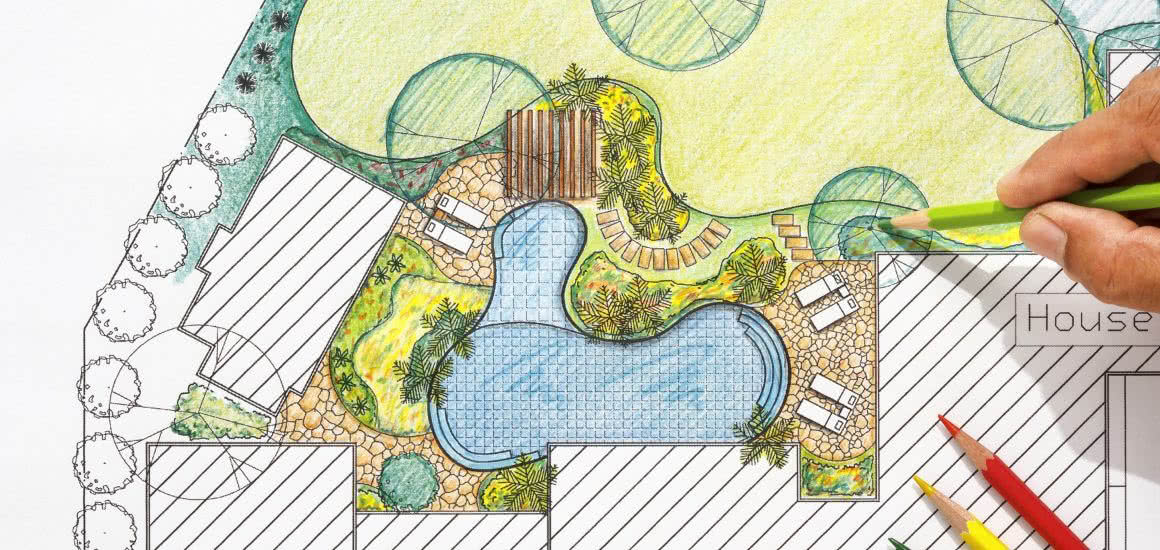Helping clients plan a landscaping job
As anyone with a few garden landscaping or redesign projects under their belt knows all too well, making sure you have the right permissions for outdoor work is an essential first step of the journey.
In most cases, you will of course just trust your judgement as to whether you’re likely to need planning permission or not. If it’s a very simple landscaping job your client is after, it’s easy to reassure them straight away that they are unlikely to need permission.
However, if your client’s vision is a bit more complex or their property is a listed building or sits in a conservation area, you will probably want to give them a heads-up as early as possible that planning permission might be required.
-
1. Clarity for your client
No doubt you’ve encountered your fair share of clients with minimal knowledge of the processes surrounding planning permission. Some people may assume planning permission is a requirement restricted to major building projects, not realising that even relatively minor features such as decorative fencing or timber decking may need clearance.
Talking through some of the points on the list below with your client will give them a good idea of why planning permission might be relevant to their project after all.
Location, location, location
Explain to your client that, unfair though it may feel, planning permission requirements can be a bit of a postcode lottery, varying from council to council. If your client’s property happens to lie in a conservation area or an Area of Outstanding Natural Beauty, you’ll need to prepare them for the fact that any significant changes – including to the garden, its stone wall or any structures within it – will likely need permission.
Listed buildings
People who live in listed buildings sometimes assume that the listed status doesn’t extend to the garden. To avoid any nasty surprises further down the line, make sure that your client knows from the beginning that even minor changes such as installing garden decking or decorative fencing will require consent if the building is listed.
Fences, walls and hedges
As you will no doubt already know, you’re going to need permission for any boundary structure over two metres high, and over one metre high if it’s by a public highway. If you’re dealing with a garden fence, this is straightforward enough. Hedges can be a bit more problematic since they grow, and your client might not always realise that there will be restrictions on hedge height in their area. It may fall to you to check they’re prepared to keep their hedge maintained.
Outbuildings
As you’ll know from experience, many clients are surprised to learn that even putting up a kennel in their garden may require planning permission. If they have requested a shed, swimming pool, pond, greenhouse or other permanent structure, have a chat to make sure they’re being realistic about what will be involved in getting permission for their outbuilding plans.
Trees
Since trees often tend to be protected by Tree Preservation Orders, you probably already have experience of suggesting amendments to client plans that involve removal of trees without good reason. If they’re planning on planting more trees, on the other hand, you might need to ask if they’ve considered possible impacts on the level of light entering neighbours’ houses.
Protected habitats and species
If your client’s plan is likely to affect protected habitats or species, flag this to them as soon as possible as a common reason for permission being denied. It might seem obvious that bat colonies, for example, can’t be harmed, but some clients may be used to viewing such creatures exclusively as pests.
Driveways
Does your client’s plan involve a large driveway built from impermeable driveway paving? If so, it can be worth checking if they know this will need planning permission, whereas a gravel driveway probably won’t. The latest regulations around drainage state that surfaces of less than five metres square or surfaces of any size that are made from permeable materials, such as gravel, can be built without planning permission.
Even if an impermeable material is used, applying for planning permission can be avoided if rainwater drains naturally to a lawn or is directed to a soakaway. If you decide to go down the soakaway route, we recommend the ACO StormBrixx system, which is easy to install and cost-effective.
Make sure you know your clients are aware of how regulations have changed. They might decide to revise their design to skip the admin involved in getting planning permission.

FAQs
-
How do I know if I need planning permission for a garden?
Gaining planning permission for a garden will vary depending on your client’s postcode. For any significant changes to a client’s garden that lies in a conservation area or an Area of Outstanding Natural Beauty, it’s most likely you will need permission.
If you’re planning on building a garden fence or adding hedges that are over two metres high, you will most likely need to get planning permission. Or if your client is planning on planting trees, you might need to ask if they’ve considered possible impacts on the level of light entering neighbours’ houses.
-
What permission is required for a driveway?
If you’re building a large driveway that’s built from impermeable paving, you may require planning permission. Make sure your client is aware of this before they settle on their landscaping designs.
According to the latest drainage regulations, gravel driveways generally do not require planning permission.
-
What drainage do I need to consider when installing a driveway?
When installing a drainage system, you will need to consider the surface of the driveway. For example, a gravel driveway will make drainage less complex than other surfaces. Whatever type of drainage system you’re installing, you will want to ensure you have high quality plastic or concrete, so that your finished channel has the ideal shape. For land drain systems, you may also need to think about planning permission.



